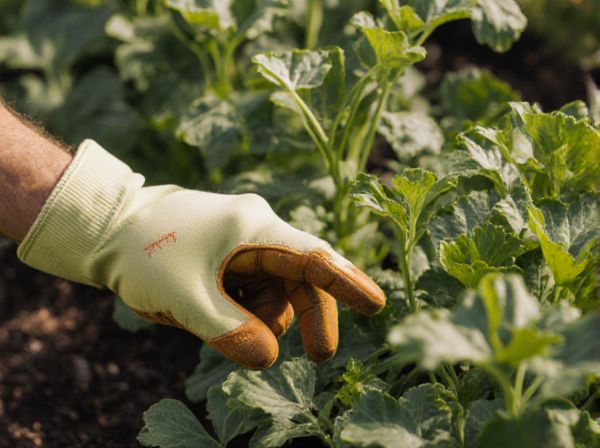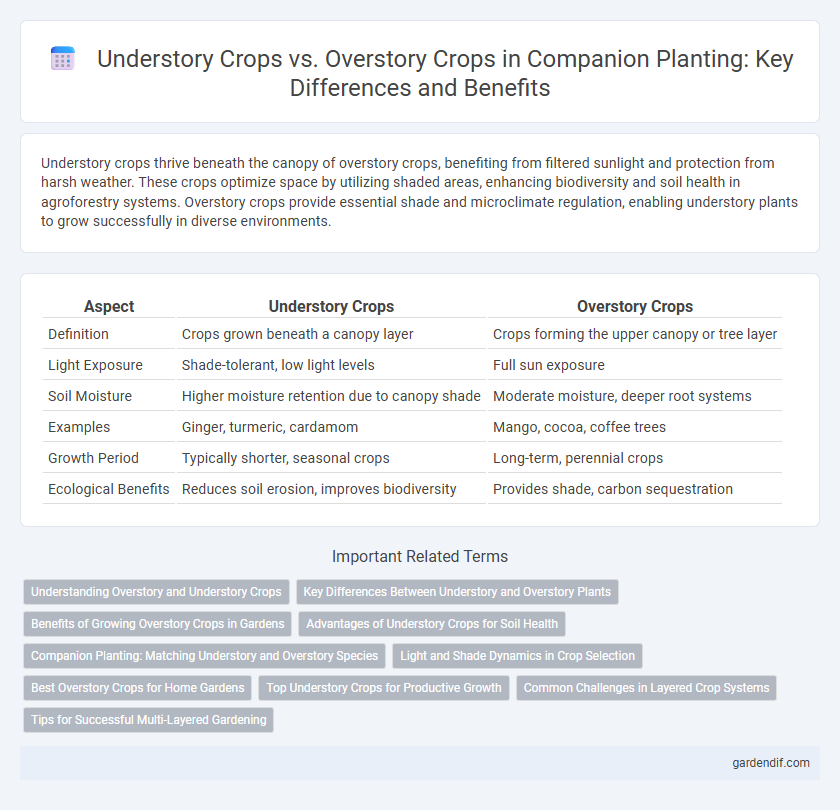
Understory crops vs overstory crops Illustration
Understory crops thrive beneath the canopy of overstory crops, benefiting from filtered sunlight and protection from harsh weather. These crops optimize space by utilizing shaded areas, enhancing biodiversity and soil health in agroforestry systems. Overstory crops provide essential shade and microclimate regulation, enabling understory plants to grow successfully in diverse environments.
Table of Comparison
| Aspect | Understory Crops | Overstory Crops |
|---|---|---|
| Definition | Crops grown beneath a canopy layer | Crops forming the upper canopy or tree layer |
| Light Exposure | Shade-tolerant, low light levels | Full sun exposure |
| Soil Moisture | Higher moisture retention due to canopy shade | Moderate moisture, deeper root systems |
| Examples | Ginger, turmeric, cardamom | Mango, cocoa, coffee trees |
| Growth Period | Typically shorter, seasonal crops | Long-term, perennial crops |
| Ecological Benefits | Reduces soil erosion, improves biodiversity | Provides shade, carbon sequestration |
Understanding Overstory and Understory Crops
Overstory crops, typically tall and canopy-forming plants like trees, provide shade and protection, influencing microclimates and soil moisture levels beneath them. Understory crops grow beneath this canopy, benefiting from filtered light and reduced wind exposure, which can enhance their growth and resilience. Understanding the dynamic between overstory and understory crops is crucial for optimizing companion planting systems and improving overall agroforestry productivity.
Key Differences Between Understory and Overstory Plants
Understory crops thrive beneath the canopy of taller overstory plants, adapting to lower light conditions and typically requiring less water and nutrients. Overstory crops dominate the ecosystem by capturing most sunlight and influencing microclimates, which shapes the growth environment for understory species. The key differences lie in their light requirements, spatial positioning, and ecological roles within agroforestry or forest garden systems.
Benefits of Growing Overstory Crops in Gardens
Growing overstory crops in gardens enhances biodiversity by providing shade and habitat for beneficial insects, improving microclimate conditions that support the growth of understory plants. These tall crops reduce soil erosion and retain moisture, promoting healthier root development for companion plants below. Overstory crops also contribute to nutrient cycling by dropping organic matter, which enriches the soil and boosts overall garden productivity.
Advantages of Understory Crops for Soil Health
Understory crops improve soil health by enhancing ground cover, reducing erosion, and increasing organic matter through leaf litter and root biomass. These crops promote microbial diversity and nutrient cycling, leading to improved soil structure and fertility. Their shaded growth reduces moisture loss, maintaining optimal soil hydration critical for sustained cultivation.
Companion Planting: Matching Understory and Overstory Species
Companion planting leverages the complementary growth patterns of understory and overstory crops to maximize space and resource efficiency. Understory species like leafy greens or herbs thrive in the shaded microclimate created by taller overstory crops such as fruit trees or nut-bearing plants. This ecological pairing enhances biodiversity, improves soil health through diverse root systems, and boosts overall crop yield by reducing pest pressures and optimizing nutrient uptake.
Light and Shade Dynamics in Crop Selection
Understory crops thrive under filtered light conditions provided by overstory crops, optimizing photosynthesis in shaded environments and improving overall land productivity. Overstory crops, such as tall trees or canopy plants, regulate light intensity and create microclimates that protect understory crops from excessive sunlight and temperature stress. Selecting complementary species based on light and shade dynamics enhances crop resilience, resource use efficiency, and biodiversity in agroecosystems.
Best Overstory Crops for Home Gardens
Best overstory crops for home gardens include fruit and nut trees such as apple, pear, and chestnut, which provide shade and protection while supporting biodiversity. These crops improve microclimate conditions, reducing temperature extremes and conserving soil moisture for understory plants like herbs, leafy greens, and root vegetables. Integrating nitrogen-fixing overstory species like black locust further enhances soil fertility, promoting healthy growth across companion plant layers.
Top Understory Crops for Productive Growth
Top understory crops such as shade-tolerant leafy greens, medicinal herbs, and low-light root vegetables thrive beneath overstory crops by efficiently utilizing filtered sunlight and conserving soil moisture. These crops enhance biodiversity, improve soil health through organic matter contribution, and provide continuous ground cover that suppresses weeds and reduces erosion. Popular choices like spinach, ginger, and turmeric demonstrate productive growth under tree canopies, maximizing land use without competing directly with taller overstory plants.
Common Challenges in Layered Crop Systems
Understory crops often face limited light availability due to shading from overstory crops, resulting in reduced photosynthesis and growth. Soil nutrient competition between layers can lead to nutrient deficiencies, impacting overall crop health and yield. Pest and disease management becomes complex, as pests may transfer between the overstory and understory, complicating integrated pest management strategies.
Tips for Successful Multi-Layered Gardening
Understory crops, such as leafy greens and shade-tolerant herbs, thrive beneath taller overstory crops like fruit trees and towering vegetables, optimizing garden space and enhancing biodiversity. Selecting compatible plants based on light and nutrient requirements ensures balanced growth and reduces competition between layers. Implementing strategic spacing, consistent soil moisture, and mindful pruning of overstory crops supports healthy understory development and maximizes overall garden productivity.
Understory crops vs overstory crops Infographic

 gardendif.com
gardendif.com